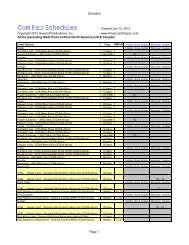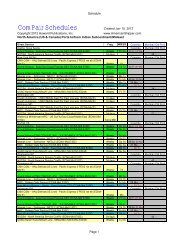Create successful ePaper yourself
Turn your PDF publications into a flip-book with our unique Google optimized e-Paper software.
LOGISTICSfor workers in India, primarily due to the informationtechnology and business processoutsourcing boom, as employees move fromone job to another to obtain higher salariesor better benefits.”But the outlook for India only gets betterfor those who invest early, Meyer said.“India’s investment potential will continueto grow for many years,” she said.“Its rising middle class and young, highlyeducated population is buying at an acceleratingpace. We’ve also seen significantgovernment investment in the country’sinfrastructure, such as power plants, roads,ports, airports, irrigation and water supplies,and telecommunications.”Content With 2nd? “It’s clear Indiawill be a follower to China,” said UdayKarmarkar, a professor of decisions, operationsand technology management atUCLA’s Anderson School of Management.“There was a time they could have followedKorea as the next big manufacturer, but thatopportunity was missed.”Karmarkar said that failure to take advantagestill haunts the country today. He saidIndia’s manufacturing sector slowly suffocatedduring Britain’s colonization, whichended in 1947 when India gained independenceand partitioned with Pakistan.Despite its clear place in line behindChina, Karmarkar said India can transitionsmoothly to a manufacturing-basedeconomy. After all, its long produced textiles— dungarees and khakis both originatedin India.“China has grabbed the lead and theywill be impossible to catch,” he said. “Theyare amazingly good at manufacturing.They make everyone else look slow. So theproblem for India will be that it’s the secondchoice. There are clear thinkers who knowwhat’s going on. Unfortunately, when youmake progress, it doesn’t happen uniformly.When you invest $5 in something, otherswonder why they don’t have $5 themselves.As (former Prime Minister) Indira Gandhisaid, ‘Progress is not in a straight line.’ ”Karmarkar said India only needs foreigninvestment to turn it into a global manufacturinggiant.“India is quite well-positioned to exportto the Middle East and Europe,” he said.“There’s not a shortage of capability. It’sjust a matter of investment.”Chemicals, pharmaceuticals, auto partsand apparel are the markets India is likelyto quickly find success in the global market,Karmarkar said, as well as microchip andindustrial equipment manufacturing.Dutta said India realizes it is fighting forsecond place in the global pecking order, butthat that’s a pretty good position to be in.18 AMERICAN SHIPPER: FEBRUARY <strong>2006</strong>“There’s a reality at this point in time,”Dutta said. “You look at the trajectoryChina has been on, and you see that theyhave had at least a 15-year lead in openingtheir country to investment. But there arestill specialized electronic components thatare more cost-effective here than in China.There are manufacturing niche markets thatrequire technological skills. That said, Indiawon’t overtake China in terms of mass-scalemanufacturing.”But as India relaxes its policies on foreigninvestment and grapples with how to makelabor laws less daunting for investors abroad,things are changing.From Ag To Manufacturing. Duttasaid the diamond trade in Surat, and textilesmanufacturing in other smaller cities, providea keyhole through which the future ofthe economy can be glimpsed. Industry willset up in smaller cities along the highwaynetwork, near large rural populations eagerto work, and away from cities, where labormovements are strong.“In India, the costsassociated with movingfreight are someof the highest in the worldat 11 percent of the landedcost of cargo. Thiscompares with a globalaverage of just 6 percent.”He also expects to see India followChina’s lead in developing special exportzones, where businesses are not governedby labor laws.“These people from the villages come toSurat and earn five times what they are makingback home,” he said. “Even (technologyofficials) recognize employment generationwill come from these manufacturing sectors,not IT.”Karmarkar said the remnants of the feudalland ownership system first implementedafter independence — where no landownercould own more than 40 acres — havecreated a dependence on agriculture foremployment, without ever being terriblyefficient from a bottom line standpoint.He said the country’s output of agricultureaccounts for only 20 percent of GDP,yet 60 percent of employment in India istied to agriculture. India’s IT employees,for example, account for only 10 percentof the country’s workforce.“The county boys want to go to the city— that’s the same everywhere,” Karmarkarsaid. “If you’re a farmer, you’re not doingwell. A lot of people are on the brink ofstarvation. There’s a large young populationmoving to the cities and bringing withit problems of their own. The real solutionis to move people out of agriculture intomanufacturing.”Again, it’s a question of tapping into adifferent demographic than the people likelyto work in IT or other services.“Farm boys can work in factories,” Karmarkarsaid. “That’s sort of the <strong>American</strong>model. But they can’t move to softwaredesign. Right now, we lack those entrepreneurslike John Deere.”Yet India still has enough skilled employeesto lure sophisticated manufacturing awayfrom China in some markets.“India is still viewed as a preferred globaloffshore location for information technologyand business process outsourcing. Butit is also moving beyond call-center workand basic software development to moresophisticated labor, such as semiconductordesign and manufacturing,” Hoover’sMeyer said. “Skills in precision engineeringalso make the auto components and medicalinstruments manufacturing industries areasto look to for further growth.”Problem Areas. Along with transportationinfrastructure comes the problemof power. Like China, India is becominga consumer of energy to rival the UnitedStates, and the three nations are racing tosecure energy sources worldwide.Dutta said Indian industrial facilities,like its well-chronicled IT campuses inBangalore, often rely on their own powergeneration to get around frequent blackoutsin the government-run grid.Yet it’s expensive, and adds to the costof making goods if power to run plants ismore expensive.India is tying up long-term natural gasagreements with Russia and is likely todevelop more nuclear power plants.“I’m less hopeful on that system than Iam on infrastructure,” Dutta said. “Maybein another 10 years.”But to Glenn, time is the main problem.“The only real risk I see is that economicreforms get bogged down in politics,” hesaid. “Political realities could affect the paceof reform. I wouldn’t rate that risk as veryhigh, but then again, politics is an endlessgame of compromise. Beyond that, I don’tview anything as even remotely likely tointerrupt or reverse the progress that’s beenmade so far.”










